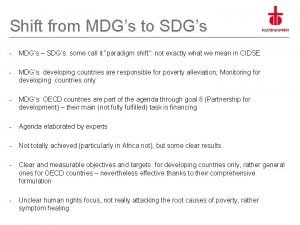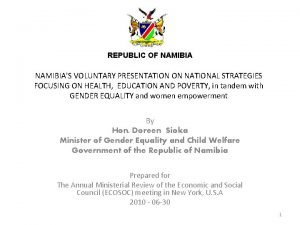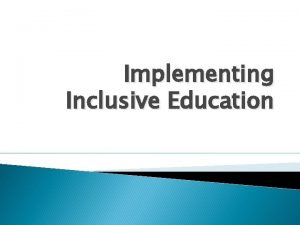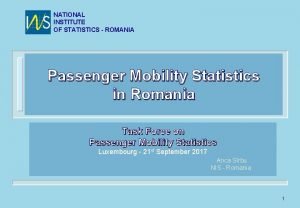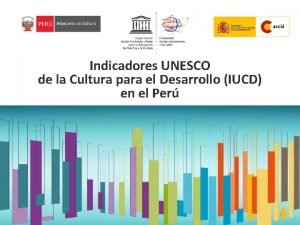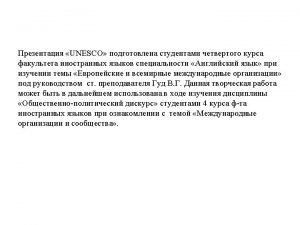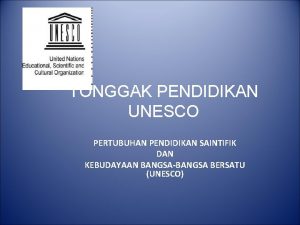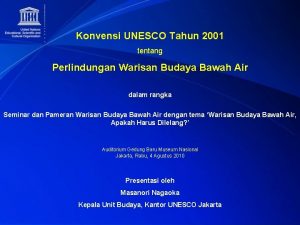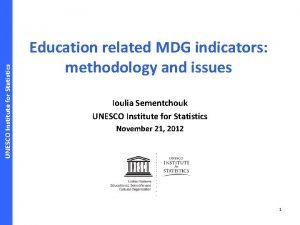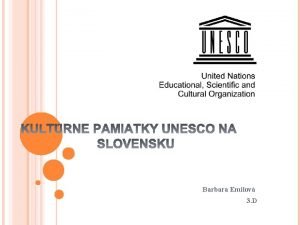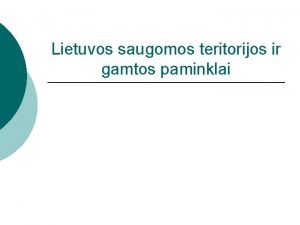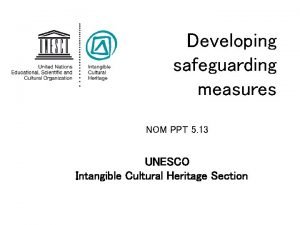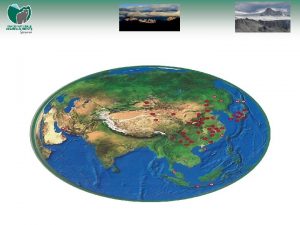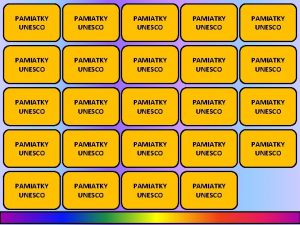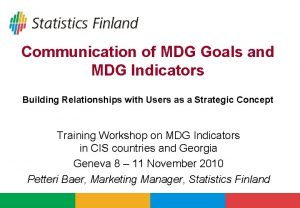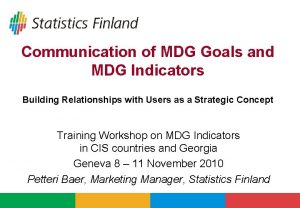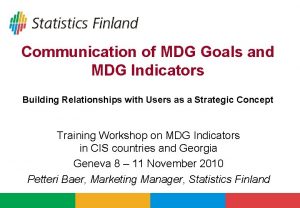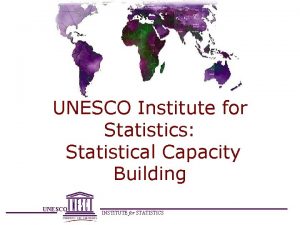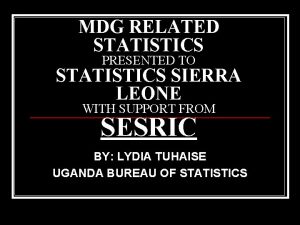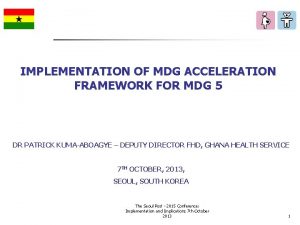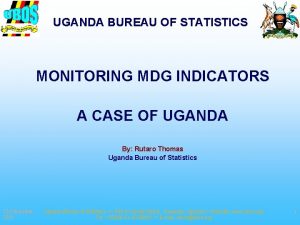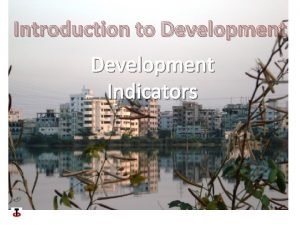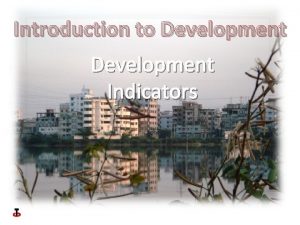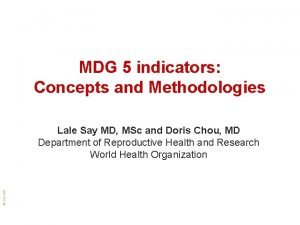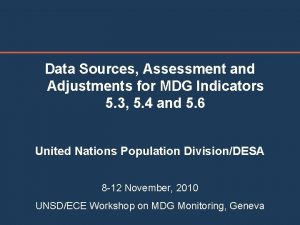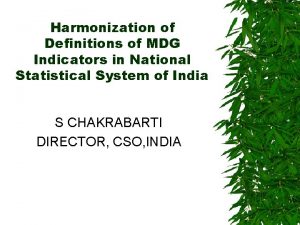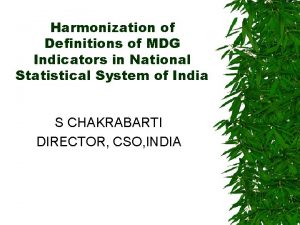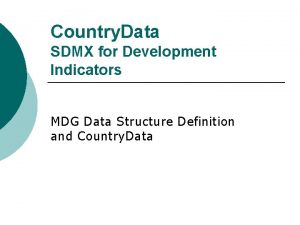UNESCO Institute for Statistics Education related MDG indicators

















































- Slides: 49

UNESCO Institute for Statistics Education related MDG indicators: methodology and issues Ioulia Sementchouk UNESCO Institute for Statistics November 21, 2012 1

UNESCO Institute for Statistics Outline p Millennium Development Goals n Goal 2: Achieve universal primary education n Goal 3: Promote gender equality and empower women 2

UNESCO Institute for Statistics Education is vital to meet all of the development goals

UNESCO Institute for Statistics Goal 2 p Achieve universal primary education Target 2. A: Ensure that, by 2015, children everywhere, boys and girls alike, will be able to complete a full course of primary schooling 4

UNESCO Institute for Statistics Monitoring indicators: Target 2. A Ensure that, by 2015, children everywhere, boys and girls alike, will be able to complete a full course of primary schooling Participation Net enrolment rate Progress Survival rate to the last grade Outcome Youth literacy rate

UNESCO Institute for Statistics Participation p Indicator 2. 1: Net enrolment rate in primary education 6

UNESCO Institute for Statistics Net enrolment rate (NER) p Definition: Percentage of children of the official primary school age group who are enrolled in primary education. p Calculation: Divide the number of pupils of the official primary age group who are enrolled in primary education by the population for the same age group and multiply the result by 100.

UNESCO Institute for Statistics Net enrolment rate (NER) 8

UNESCO Institute for Statistics Republic of Moldova (2011) Entry age: 7 year old Duration: 4 years Official age group: 7 -10 Age Population Enrolment in primary education 5 37, 472 19 6 37, 484 5, 088 7 36, 206 32, 111 8 36, 373 33, 983 9 37, 196 33, 084 10 38, 122 30, 692 11 39, 200 3, 027 12 40, 777 296 13 43, 147 68 14 46, 737 47 15 49, 511 21 Total 138, 436

Recent update UNESCO Institute for Statistics p Concept of out-of-school children is redefined: n p Children of primary school age are counted as being in school when they are either in primary or secondary education. Adjusted NER (NERA) is more appropriate to monitor MDGs n NERA: including primary school age in secondary education

UNESCO Institute for Statistics Adjusted net enrolment rate (NERA) p Definition: Percentage of children of the official primary school age group who are enrolled in primary or secondary education. p Calculation: Divide the total number of pupils in the official primary school age range who are enrolled in primary or secondary education in a given school year by the population of the same age group and multiply the result by 100. 11

UNESCO Institute for Statistics Adjusted net enrolment rate (NERA) 12

Republic of Moldova (2011) UNESCO Institute for Statistics Official age group: 7 -10 Age Population Enrolment in primary education Enrolment in secondary education Total enrolment 7 36, 206 32, 111 n 32, 111 8 36, 373 33, 983 n 33, 983 9 37, 196 33, 084 38 33, 122 10 38, 122 30, 692 4, 054 34, 746 Total 147, 897 129, 870 4, 092 133, 962

UNESCO Institute for Statistics NER vs NERA 24

Adjusted net enrolment rate UNESCO Institute for Statistics p Interpretation: Increasing NERA might reflect improving participation of children in the official primary school age, the decrease of the target population or both. A value of 100% might indicate that the country has accomplished the UPE goal. However, this condition is not sufficient for UPE due to, for example, a high repetition rate, which might lead pupils to dropout after primary school age without completing primary education.

UNESCO Institute for Statistics Adjusted net enrolment rate p Limitations: The theoretical maximum of NERA is 100 per cent. However, the NERA may exceed this maximum due to inconsistencies between population and enrolment data derived from different data sources. School enrolments may be over or under-reported for various reasons. 16

UNESCO Institute for Statistics Progress p Indicator 2. 2: Proportion of pupils starting grade 1 who reach the last grade of primary 17

UNESCO Institute for Statistics Survival rate to the last grade of primary education p Definition: Percentage of a cohort of pupils enrolled in the first grade who are expected to reach the last grade of primary education, regardless the repetition. p Rationale: This indicator measures an education system’s success in retaining students from one grade to the next as well as its internal efficiency. Various factors account for poor performance on this indicator, including low quality of schooling, discouragement over poor achievement and the direct and indirect costs of schooling. Students’ progress to higher grades may also be limited by the availability of teachers, classrooms and educational materials.

UNESCO Institute for Statistics Survival rate to the last grade of primary education Calculation: The survival rate is calculated on the basis of the reconstructed cohort method, which uses data on enrolment and repeaters for two consecutive years. This method makes three assumptions: n n n drop-outs never return to school; promotion, repetition and drop-out rates remain constant over the entire period in which the cohort is enrolled in school; the same rates apply to all pupils enrolled in a given grade, regardless of whether they previously repeated a grade.

UNESCO Institute for Statistics Albania (2010) Primary education Grade 1 Grade 2 Grade 3 Grade 4 Grade 5 2010 Enrolment 42, 673 39, 500 46, 966 47, 569 48, 073 2011 Enrolment 39, 932 41, 989 39, 272 46, 801 47, 666 2011 Repeaters 572 298 245 521 20

UNESCO Institute for Statistics Survival rate to the last grade of primary education, 1999 and 2010 1999 120 100 80 60 40 20 0 Albania Armenia Azerbaijan Bosnia and Herzegovina Georgia Republic of Moldova Tajikistan 21

Survival rate to the last grade of primary education UNESCO Institute for Statistics p Interpretation: Indicator values range from 0% (none of the pupils starting grade 1 reach the last grade) to 100% (all of the pupils reach the last grade). Survival Rates approaching 100 per cent indicate a high level of retention and a low incidence of dropout. It is important to note that it does not imply that all children of school age complete primary education. The Survival Rate is a percentage of a cohort of pupils (that is, children who have already entered school) and not a percentage of children of school age.

Survival rate to the last grade of primary education UNESCO Institute for Statistics p Limitations: Since the calculation of the proportion of pupils starting grade 1 who reach last grade of primary is based on pupil-flow rates, the reliability of the survival rate depends on the consistency of data coverage on enrolment and repeaters over time and across grades. p Given that this indicator is usually estimated using cohort analysis models that are based on a number of assumptions, care should be taken in using the results in comparisons.

UNESCO Institute for Statistics Gross intake ratio to the last grade – Proxy measure of primary completion p Definition: Total number of new entrants in the last grade of primary education, regardless of age, expressed as a percentage of the population at theoretical entrance age to the last grade of primary. p Calculation: Divide the number of new entrants in last grade of primary, regardless of age, by the population of theoretical entrance age to the last grade of primary, and multiply the result by 100.

UNESCO Institute for Statistics Gross intake ratio to the last grade of primary education 25

UNESCO Institute for Statistics Gross intake ratio to the last grade of primary education p Limitations: The calculation includes all new entrants to the last grade (regardless of age). Therefore, the ratio can exceed 100%, due to over-aged and under-aged children who enter primary school late/early and/or repeat grades in previous years. However, in the long run the Gross intake ratio to the last grade should approach 100%.

UNESCO Institute for Statistics Gross intake rate to the last grade of primary education, 1999 and 2011

UNESCO Institute for Statistics Outcome p Indicator 2. 3: Literacy rate of 15 - to 24 -year-old women and men 28

UNESCO Institute for Statistics Youth literacy rate (15 -24 years) p Definition: Percentage of people aged 15 to 24 years who can both read and write with understanding a short, simple statement on their everyday life. p Calculation: Divide the number of people aged 15 to 24 years who are literate by the total population in the same age group and multiply the result by 100.

UNESCO Institute for Statistics Youth literacy rate (15 -24 years) 30

Youth literacy rate (15 -24 years) UNESCO Institute for Statistics p p Interpretation: The indicator ranges from 0% (all youth are illiterate) to 100% (all youth are literate). Literacy rates below 100 per cent indicate the need to increase school participation and education quality. Rationale: The youth literacy rate reflects the outcomes of the primary education system over the previous 10 years, and is often seen as a proxy measure of social progress and economic achievement. The literacy rate is the complement of the illiteracy rate. It is not a measure of the adequacy of the literacy levels needed for individuals to function and participate in a society (functional literacy).

UNESCO Institute for Statistics Youth literacy rate (15 -24 years)

UNESCO Institute for Statistics Youth literacy rate (15 -24 years)

UNESCO Institute for Statistics Youth literacy rate (15 -24 years) p Limitations: Some countries apply definitions and criteria for literacy which are different from the international standard defined above, or equate persons with no schooling to illiterates, or change definitions between censuses. p Practices for identifying literates and illiterates during actual census enumeration may also vary. Errors in literacy selfdeclaration can affect the reliability of the statistics.

UNESCO Institute for Statistics Gender parity index (GPI) Definition: Ratio of female to male values of a given indicator. p Purpose: The GPI measures progress towards gender parity in education participation and/or learning opportunities available for girls in relation to those available to boys. p Calculation: Divide the female value of an indicator by the male value of the same indicator. p

UNESCO Institute for Statistics Gender parity index (GPI) Where: GPIGER Gender parity index for Gross enrolment ratio GERFemale Gross enrolment ratio for female GERMale Gross enrolment ratio for male 36

UNESCO Institute for Statistics Gross enrolment ratio (GER) p p Definition: Total enrolment in a specific level of education, regardless of age, expressed as a percentage of the official school-age population corresponding to the same level of education. Calculation: Divide the number of pupils enrolled in a given level of education regardless of age by the population of the age group which officially corresponds to the given level of education, and multiply the result by 100.

UNESCO Institute for Statistics Gross enrolment ratio (GER)

UNESCO Institute for Statistics Bosnia and Herzegovina (2011) Age 6 7 8 9 10 11 12 13 14 15 Total School-age population Female Male 16, 690 17, 833 17, 398 18, 586 18, 198 19, 435 19, 042 20, 331 20, 012 21, 351 91, 340 97, 536 Enrolment in primary education Female Male 14, 477 15, 213 16, 484 17, 351 16, 273 17, 357 17, 352 18, 151 16, 716 17, 503 1, 639 1, 969 72 104 28 38 14 22 32 47 83, 087 87, 755

UNESCO Institute for Statistics Measuring gender parity GER for Primary education, 2011 Gender parity index – an index of 1. 00 is perfect parity, and 0. 97 – 1. 03 is considered a zone of gender parity ↓ ↓ ↓ 1. 00 Higher rate among boys Higher rate among girls Perfect parity Tajikistan Albania Georgia Girls GER 98. 4 85. 4 108. 1 Boys GER 102. 4 86. 4 105. 0 GPI 0. 96 0. 99 1. 03

Gender parity index by level of education, 1999 and 2011 UNESCO Institute for Statistics The horizontal green bar represents the zone of gender parity Primary education Secondary education Tertiary education 41

UNESCO Institute for Statistics Gender parity index (GPI) p Limitations: The index does not show whether improvement or regression is due to the performance of one of the gender groups (boys or girls). Interpretation of the GPI requires trend analysis of the underlying GER values.

Additional indicators for analysis Are there enough places for all children? p Gross enrolment ratio n Do children start school at the right age? p Gross intake rate p Net intake rate p Adjusted net intake rate n Do all children go to school? p Numbers of children out-of-school UNESCO Institute for Statistics n 43

Additional indicators for analysis How do children progress through the system? p Promotion rate p Repetition rate n Do children complete primary education? p Primary completion rate UNESCO Institute for Statistics n 44

UNESCO Institute for Statistics Azerbaijan (2011) p Most children are in school but NERA is low - why? Entry age: 6 year old Duration: 4 years Official age group: 6 -9 Age Population Enrolment in primary education Enrolment in secondary education 5 120, 999 8, 986 n 6 121, 286 96, 895 n 7 132, 395 113, 448 n 8 127, 083 115, 544 n 9 124, 368 111, 621 3, 311 10 129, 599 31, 393 77, 913 Total 505, 132 437, 508 3, 311 45

UNESCO Institute for Statistics Azerbaijan (2011) p NERA vs GER in primary education 46

UNESCO Institute for Statistics Azerbaijan (2011) p Percentage of 6 - and 7 -year-olds in primary grade 1

UNESCO Institute for Statistics Azerbaijan (2011) p Reason for low NERA: late entry into primary school Age Entry age: 6 year old Population Enrolment in Grade 1 of primary education 5 120, 999 68 6 121, 286 92, 578 7 132, 395 25, 678 8 127, 083 1, 627 9 124, 368 13 10 129, 599 16 11 134, 296 15 12 138, 566 3 Total 119, 998

UNESCO Institute for Statistics Contact information Ioulia Sementchouk Education Indicators and Data Analysis UNESCO Institute for Statistics i. sementchouk@unesco. org www. uis. unesco. org 49
 Unesco institute for statistics
Unesco institute for statistics Gross enrolment ratio meaning
Gross enrolment ratio meaning Why shift from mdg to sdg
Why shift from mdg to sdg Mdg
Mdg Four pillars of education
Four pillars of education Unesco inclusive education
Unesco inclusive education Two types of physical
Two types of physical What is skill-related fitness? *
What is skill-related fitness? * National institute of statistics romania
National institute of statistics romania Introduction to statistics what is statistics
Introduction to statistics what is statistics Physical education in primitive society
Physical education in primitive society Unesco stands for
Unesco stands for Unesco volunteer
Unesco volunteer Pengertian buku menurut unesco
Pengertian buku menurut unesco Australia pamiatky
Australia pamiatky Pamiatky unesco v amerike
Pamiatky unesco v amerike Organizzazioni internazionali scuola primaria
Organizzazioni internazionali scuola primaria Indicadores unesco de cultura para el desarrollo
Indicadores unesco de cultura para el desarrollo Alexander leicht unesco
Alexander leicht unesco Pamiatky unesco australia
Pamiatky unesco australia Vad gör unesco
Vad gör unesco Unesco objective
Unesco objective Tonggak pendidikan unesco
Tonggak pendidikan unesco Field offices unesco
Field offices unesco Unesco quiz
Unesco quiz Konvensi unesco 2001
Konvensi unesco 2001 Ccf was developed by unesco
Ccf was developed by unesco Unesco
Unesco Aleksandra popovic unesco
Aleksandra popovic unesco Unesco
Unesco Unesco motto
Unesco motto Conclusion of unesco
Conclusion of unesco Lietuvos saugomos teritorijos
Lietuvos saugomos teritorijos Akhmetova
Akhmetova Unesco conclusion
Unesco conclusion Unesco ramallah
Unesco ramallah Nuria sanz unesco
Nuria sanz unesco Unesco ppt
Unesco ppt Taliansko pamiatky unesco
Taliansko pamiatky unesco Offerta conferenze internazionale geoparchi mondiali unesco
Offerta conferenze internazionale geoparchi mondiali unesco Akropola v aténach
Akropola v aténach Outlook unesco
Outlook unesco Unesco dg
Unesco dg Unesco child and family research centre
Unesco child and family research centre Ifla unesco
Ifla unesco Formuö
Formuö Typiska novell drag
Typiska novell drag Tack för att ni lyssnade bild
Tack för att ni lyssnade bild Ekologiskt fotavtryck
Ekologiskt fotavtryck Varför kallas perioden 1918-1939 för mellankrigstiden?
Varför kallas perioden 1918-1939 för mellankrigstiden?


